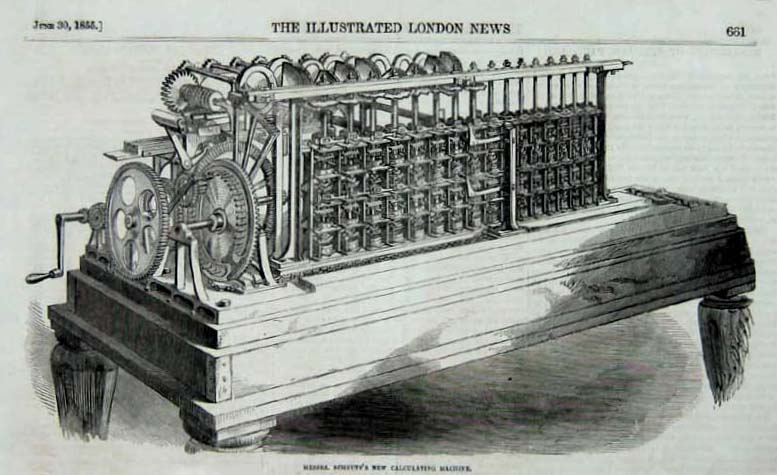
Clipping from The Illustrated London News of 30 June 1855, p. 681, showing “Messrs. Scheutz’s New Calculating Machine”. This “Scheutzian calculation engine”, designed and built by Georg and his son Edvard Scheutz, was a “difference engine”, the first of a series produced by him from 1855 onwards, and designed to calculate functions such as logarithms for tabulation. The concept was first advanced by J. H. Müller, and engineer in the Hessian army, and later advanced to a point of great sophistication by Charles Babbage, who designed his Difference Engine No. 2, in 1847–9 (and which, whilst never completed by Babbage has been reconstructed under Doron Swade at the British Science Museum for the bicentennial anniversary of Babbage’s birth).123 Despite inspiration from accounts of Babbage’s ideas, Scheutz’s design was entirely original, benefitting from his background not only in invention but also in printing.4 Scheutz’s engine, was functional, although unable to produce complete logarithmic tables. In 1875 Martin Wiberg created a re-worked version which could do the complete job of calculating and printing the tables.5
1 Doron Swade, The Cogwheel Brain: Charles Babbage and the Quest to Build the First Computer, Little, Brown and Company, London, 2000. (↑)
2 The approach used Newton’s method of differences to evaluate a polynomial in a variable, through successive values of the variable (x = 1, 2, 3…). representing the required function. Polynomials of order n can be evaluated for successive values of the variable by means of n additions of differences. (↑)
3 For a simple explanation of the method (and a way of constructing a difference engine using Lego!) see Andrew Carol, “A working hand-cranked Difference Engine made using LEGO® pieces”, viewed 5 July 2012. (↑)
4 Swade, The Cogwheel Brain, pp. 193–210. (↑)
5 ibid, pp. 313–4. (↑)
Pages linked to this page
 This work by Jim Falk is licensed under a Creative Commons Attribution-NonCommercial-NoDerivs 3.0 Unported License Click on the logo to the left to see the terms on which you can use it.
This work by Jim Falk is licensed under a Creative Commons Attribution-NonCommercial-NoDerivs 3.0 Unported License Click on the logo to the left to see the terms on which you can use it.